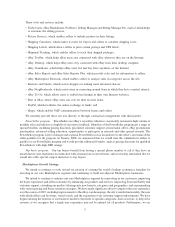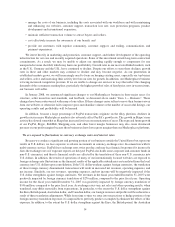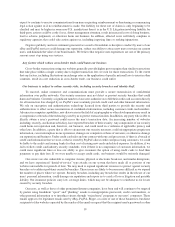eBay 2007 Annual Report Download - page 24
Download and view the complete annual report
Please find page 24 of the 2007 eBay annual report below. You can navigate through the pages in the report by either clicking on the pages listed below, or by using the keyword search tool below to find specific information within the annual report.• manage the costs of our business, including the costs associated with our workforce and with maintaining
and enhancing our websites, customer support, transaction loss rate, user protection programs, product
development and international expansion;
• maintain sufficient transaction volume to attract buyers and sellers;
• cost effectively increase the awareness of our brands; and
• provide our customers with superior community, customer support, and trading, communication, and
payment experiences.
We invest heavily in marketing and promotion, customer support, and further development of the operating
infrastructure for our core and recently acquired operations. Some of this investment entails long-term contractual
commitments. As a result, we may be unable to adjust our spending rapidly enough to compensate for any
unexpected revenue shortfall, which may harm our profitability. Growth rates in our most established markets, such
as the U.S., Germany and the U.K., have continued to decline. Despite our efforts to stem these declines, growth
rates in these and other markets may continue to decline and may become negative. As our penetration in
established markets grows, we will increasingly need to focus on keeping existing users, especially our top buyers
and sellers, active and increasing their activity level on our sites for growth. In addition, our Marketplaces business
is facing increased competitive pressure. If we are unable to change our services in ways that reflect the changing
demands of the ecommerce marketplace, particularly the higher growth of sales of fixed-price, new in-season items,
our business will suffer.
In January 2008, we announced significant changes to our Marketplaces business in three major areas: fee
structure, seller incentives and standards, and feedback, as discussed above under “Item 1 — Business”. These
changes have been controversial with many of our sellers. If these changes cause sellers to move their business away
from our websites or otherwise fail to improve gross merchandise volume or the number of successful listings, our
operating results and profitability will be harmed.
In addition, because a large percentage of PayPal transactions originate on the eBay platform, declines in
growth rates in major Marketplaces markets also adversely affect PayPal’s growth rate. The growth in Skype’s user
activity has slowed somewhat as Skype has increased its focus on monetization of users. The expected future growth
of our PayPal, Skype, StubHub, Shopping.com, and other lower margin businesses may also cause downward
pressure on our profit margins because those businesses have lower gross margins than our Marketplaces platforms.
We are exposed to fluctuations in currency exchange rates and interest rates.
Because we conduct a significant and growing portion of our business outside the United States but report our
results in U.S. dollars, we face exposure to adverse movements in currency exchange rates. In connection with its
multi-currency service, PayPal fixes exchange rates twice per day, and may face financial exposure if it incorrectly
fixes the exchange rate or if exposure reports are delayed. PayPal also holds some corporate and customer funds in
non-U.S. currencies, and thus its financial results are affected by the translation of these non-U.S. currencies into
U.S. dollars. In addition, the results of operations of many of our internationally focused websites are exposed to
foreign exchange rate fluctuations as the financial results of the applicable subsidiaries are translated from the local
currency into U.S. dollars upon consolidation. If the U.S. dollar weakens against foreign currencies, the translation
of these foreign currency denominated transactions will result in increased net revenues, operating expenses, and
net income. Similarly, our net revenues, operating expenses, and net income will be negatively impacted if the
U.S. dollar strengthens against foreign currencies. Net revenues in the fiscal year ended December 31, 2007 were
positively impacted by foreign currency translation of $276 million, compared to the prior fiscal year. Operating
income for the fiscal year ended December 31, 2007 was positively impacted by foreign currency translation of
$146 million, compared to the prior fiscal year. As exchange rates vary, net sales and other operating results, when
translated, may differ materially from expectations. In particular, to the extent the U.S. dollar strengthens against
the Euro, British pound, Australian dollar, and Canadian dollar, our foreign revenues and profits will be reduced as a
result of these translation adjustments. While from time to time we enter into transactions to hedge portions of our
foreign currency translation exposure, it is impossible to perfectly predict or completely eliminate the effects of this
exposure. In addition, to the extent the U.S. dollar strengthens against the Euro, the British pound, the Australian
14
























